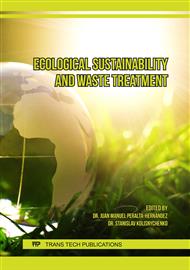[1]
Asian Development Bank (ADB), Environment, Climate Change, and Disaster Risk Management, Manila, Asian Development Bank, (2014).
Google Scholar
[2]
Thailand Development Research Institute (TDRI), Prioritizing Environmental Problems with Environmental Costs, Final report prepared the Thailand Health Fund, Bangkok, (2007).
Google Scholar
[3]
ZM. Chen, GQ. Chen, JB. Zhou, MM. Jiang, B. Chen, Ecological input–output modeling for embodied resources and emissions in Chinese economy 2005, Commun Nonlinear SciNumer Simul. 15(7) (2010) 1942–65.
DOI: 10.1016/j.cnsns.2009.08.001
Google Scholar
[4]
A. Bodini, Building a systemic environmental monitoring and indicators for sustainability: What has the ecological network approach to offer?, Ecol Indic. 15 (2012) 140–8.
DOI: 10.1016/j.ecolind.2011.09.032
Google Scholar
[5]
Allen Hammond, Albert Adriaanse, Eric Rodenburg, Dirk Bryant, Richard Woodward, Environmental indicators: A systematic approach to measuring and reporting on environmental policy performance in the context of sustainable development, World resources institute (2007).
Google Scholar
[6]
J.J. Harwick, N.D. Olewiler, The Economics of Natural Resource Use, Massachusetts, Addison-Wesley, (1988).
Google Scholar
[7]
Office of the National Economic and Social Development Board, National Income of Thailand, Bangkok, NESDB, (2015).
Google Scholar
[8]
J. Marull, J. Pino, E. Tello, MJ. Cordobilla, Social metabolism, landscape change and land-use planning in the Barcelona metropolitan region, Land Use Policy. 27(2) (2010) 497–510.
DOI: 10.1016/j.landusepol.2009.07.004
Google Scholar
[9]
D.R. Simpson, R.L. Bradford, Taxing Variable Cost: Environmental Regulation as Industrial policy, Journal of Environmental Economics and Management. 4(May), (1996) 60.
DOI: 10.1006/jeem.1996.0019
Google Scholar
[10]
Information on http: /archive. idrc. ca/ecohealth/indicators_e. html.
Google Scholar
[11]
C. Brent, Labuschagne, Social indicators for sustainable project and technology life cycle management in the process industry, The International Journal of Life Cycle Assessment. 11(1) (2006) 3-15.
DOI: 10.1065/lca2006.01.233
Google Scholar
[12]
S. Liang, T. Zhang, Urban metabolism in China: achieving dematerialization and decarbonization in Suzhou, J Ind Ecol. 15(3) (2011) 420–34.
DOI: 10.1111/j.1530-9290.2011.00343.x
Google Scholar
[13]
SS. Li, Y. Zhang, ZF. Yang, H. Liu, JY. Zhang, Ecological relationship analysis of the urban metabolic system of Beijing, China, Environ Pollut. 170 (2012) 169–76.
DOI: 10.1016/j.envpol.2012.07.010
Google Scholar
[14]
C. Kennedy, J. Cuddihy, J. Engel-Yan, The changing metabolism of cities, J Ind Ecol. 11(2) (2007) 43–59.
Google Scholar
[15]
M. Lenzen, Primary energy and greenhouse gases embodied in Australian final consumption: An input–output analysis, Energy Policy. 26(6) (1998) 495–506.
DOI: 10.1016/s0301-4215(98)00012-3
Google Scholar
[16]
S. Pantavisid, Natural Resource and Environmental Costs of Good and Service Production via Sustainable Consumption and Production Approach towards Prioritizing the Environmental Management in Thailand, Doctoral diss, Social Development and Environmental Management, School of Social and Environmental Development, National Institute of Development Administration, (2012).
DOI: 10.4324/9781315825106-13
Google Scholar
[17]
E. Hugo, Pistikopoulos, Environmentally conscious long-range planning and design of supply chain networks, Journal of Cleaner Production. 13(15) (2005) 1471-1491.
DOI: 10.1016/j.jclepro.2005.04.011
Google Scholar
[18]
Benoit, Guidelines for Social Life Cycle Assessment of Products, UNEP-SETAC, G. Guillén-Gosálbez, (2009).
Google Scholar
[19]
F. Duchin, Input–output economics and material flows, In: Suh S, editor. Handbook of input–output economics in industrial ecology, Cheltenham, Edward Elgar Publishing. Ltd., (2008).
DOI: 10.1007/978-1-4020-5737-3_2
Google Scholar
[20]
W.M. Adams, Green Development: Environment and Sustainability in the Third World, second ed., New York, Routhedge, (2009).
Google Scholar
[21]
O. Ukaga, C. Maser, M. Reichenbach, Sustainable Development: Principle, Frameworks and Case Studies, London, CRC Press Taylor and Frances Group, (2010).
DOI: 10.1201/9781439820636
Google Scholar
[22]
A.P. Duque, A. Barbosa-Póvoa, Novais, Design and planning of sustainable industrial networks: Application to a recovery network of residual products, Industrial & Engineering Chemistry Research. 49(9) (2010) 4230-4248.
DOI: 10.1021/ie900940h
Google Scholar
[23]
Grossmann, Optimal design and planning of sustainable chemical supply chains under uncertainty, American Institute of Chemical Engineers Journal. 55(1) (2009) 99- 121.
DOI: 10.1002/aic.11662
Google Scholar
[24]
E. Ness, S. Urbel-Piirsalu, L. Anderberg, Olsson, Categorizing tools for sustainability assessment, Ecological Economics. 60(3) (2007) 498-508.
DOI: 10.1016/j.ecolecon.2006.07.023
Google Scholar
[25]
A.P. Salema, A. Barbosa-Póvoa, Novais, Simultaneous design and planning of supply chains with reverse flows: A generic modelling framework, European Journal of Operational Research. 203(2) (2010) 336-349.
DOI: 10.1016/j.ejor.2009.08.002
Google Scholar
[26]
W.W. Leontief, Input-Output Economics, second ed., New York, Oxford University Press, (1986).
Google Scholar
[27]
R. Bailey, B. Bras, JK. Allen, Applying ecological input–output flow analysis to material flows in industrial systems: Part I: Tracing flows, J Ind Ecol. 8(1) (2004) 45–68.
DOI: 10.1162/1088198041269346
Google Scholar
[28]
M. Xu, Development of the physical input monetary output model for understanding material flows within ecological–economic systems, J Res Ecol. 2(1) (2010) 123–34.
Google Scholar
[29]
A. Espinosa, J. Walker, A Complexity Approach to Sustainability: Theory and Application, London, Imperial College Press, (2011).
Google Scholar
[30]
Y. Zhang, H. Liu, YT. Li, ZF. Yang, SS. Li, NJ. Yang, Ecological network analysis of China's societal metabolism, J Environ Manage. 93(1) (2012) 254–63.
Google Scholar
[31]
N. Sa-nguanwongthong, Study of Environmental Costs for the Evaluation of Industrial Development in Thailand, Doctoral diss, Social Development and Environmental Management, School of Social and Environmental Development, National Institute of Development Administration, (2013).
Google Scholar



